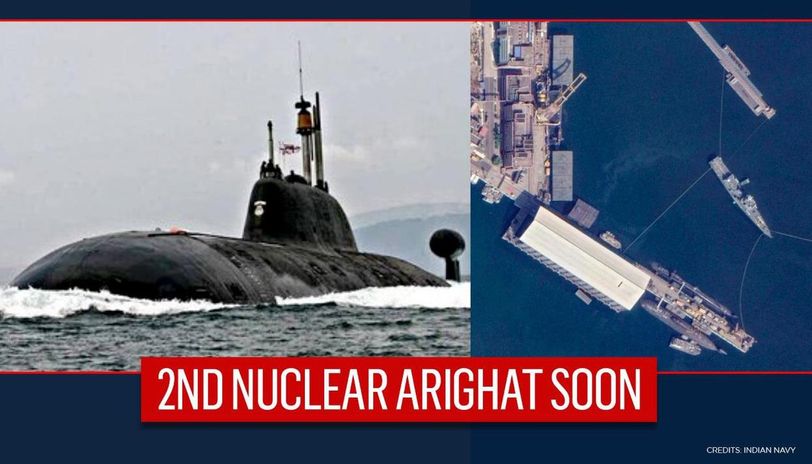Indian Navy To COMMISSION INS ARIGHAT, SSBN, EARLY NEXT YEAR

Dated : 22 Dec 2020 (IST)
After some teething troubles, India’s nuclear submarine programme — the country’s costliest defence project, was then placed under a retired FOC in C who had the unique distinction of Commanding both an Aircraft Carrier and before that INS CHAKRA, a SSGN leased from USSR. He reported directly to the PMO.
INS ARIHANT was put through its paces, one step at a time, as no mishap could be afforded. Also full secrecy had to be maintained from prying eyes and ears of both foes and friends.
It was only in October 2018, that World came to know that INS ARIHANT, its first SSBN — a nuclear powered submarine equipped with ballistic missiles carrying nuclear warheads — had completed its first deterrence patrol.
The veil of secrecy around the Operational move was of exceptional order. The second boat of the ARIHANT class was to be the ARIDHAMAN but it had been quietly pulled out for major modifications before launch only. Then after a gap which seemed a delay and keeping everyone wondering, a bigger, improved and better-armed INS ARIGHAT was launched quietly in 2017 by the then defence minister Nirmala Sitharaman. The submarine is now in the final stages of sea trials and is likely to be commissioned into service early next year. A report, citing sources, adds that the submarine has performed well during sea trials but its commissioning has been delayed by the outbreak of Covid-19.
The next two SSBNs after INS ARIHANT and ARIGHAT will be ARIDHAMAN and the fourth one S4* for now. Both are under final phases of construction at the Ship Building Centre in Visakhapatnam, and are likely to enter service with the Indian Navy some time around 2024.
INS ARIHANT displaces around 6000 ton and can carry either 12x 750 km range K15 nuclear ballistic missiles or 8x K15 and 4x K4 a 4000 km Intermediate Range Ballistic Missile. The three sister boats displace at least 1,000 tons more than the 6,000 tonne INS Arihant. The boats will be capable of carrying 8x K4 IRBMs.
Now India is already working on a plan to build six SSNs with a displacement capacity of 6,000 tonnes. Green light for this project was given in 2015, a year after the National Democratic Alliance (NDA) came to power. The initial design work had begun at the Gurgaon-based Submarine Design Centre sometime around 2017 and considerable progress has been made since.
In 2019, the government granted Rs 100 crore for the initial phase of development of these submarines. With success in the initial design phase, the programme has been cleared for the detailed design phase. This means that there will be now more resources for this project.
The Hyderabad-based, state-owned Mishra Dhatu Nigam, has been asked to develop an indigenous special alloy for the hull of the submarine to allow it to dive much deeper than the Arihant-class. The nuclear reactor being developed for the SSNs will also be more powerful than the one on the Arihant-class submarines.
Like SSBNs, SSNs powered by a nuclear reactor can remain underwater indefinitely depending on crew endurance and logistics available on board. These submarines basically are hunter killers to hunt enemy submarines and of Course surface ships. The diesel-electric submarines on the other hand have to surface at regular intervals to charge their batteries which power them under water.
According to news reports, a scale model of the SSNs will soon be fabricated and tested for design flaws. The leasing of an Akula-2 SSN from Russia for a 10-year period in a $3 billion deal earlier this year is also likely to come in handy for the development of the new type, and also for training the crew that will operate it.
Although the effort behind the projects is indigenous with 60 per cent of the components for the Arihant-class being sourced from local manufacturers, the Indian Navy has benefited from a close design-and-technical cooperation with Russia.
India is also working on the design of a new series of SSBNs, which will be a marked improvement over the Arihant-class.
Identified as S-5, this new type of submarine will have a displacement of 13,500 tonnes, which is twice that of the Arihant-class, and will be capable of carrying 12 x 5000km or higher ranges missiles as they get tested.
Currently work is going on three nuclear submarine projects — 7000 ton Arihant-class SSBNs, 6x SSNs, and the new 13,500 tonne S-5 class SSBNs.




